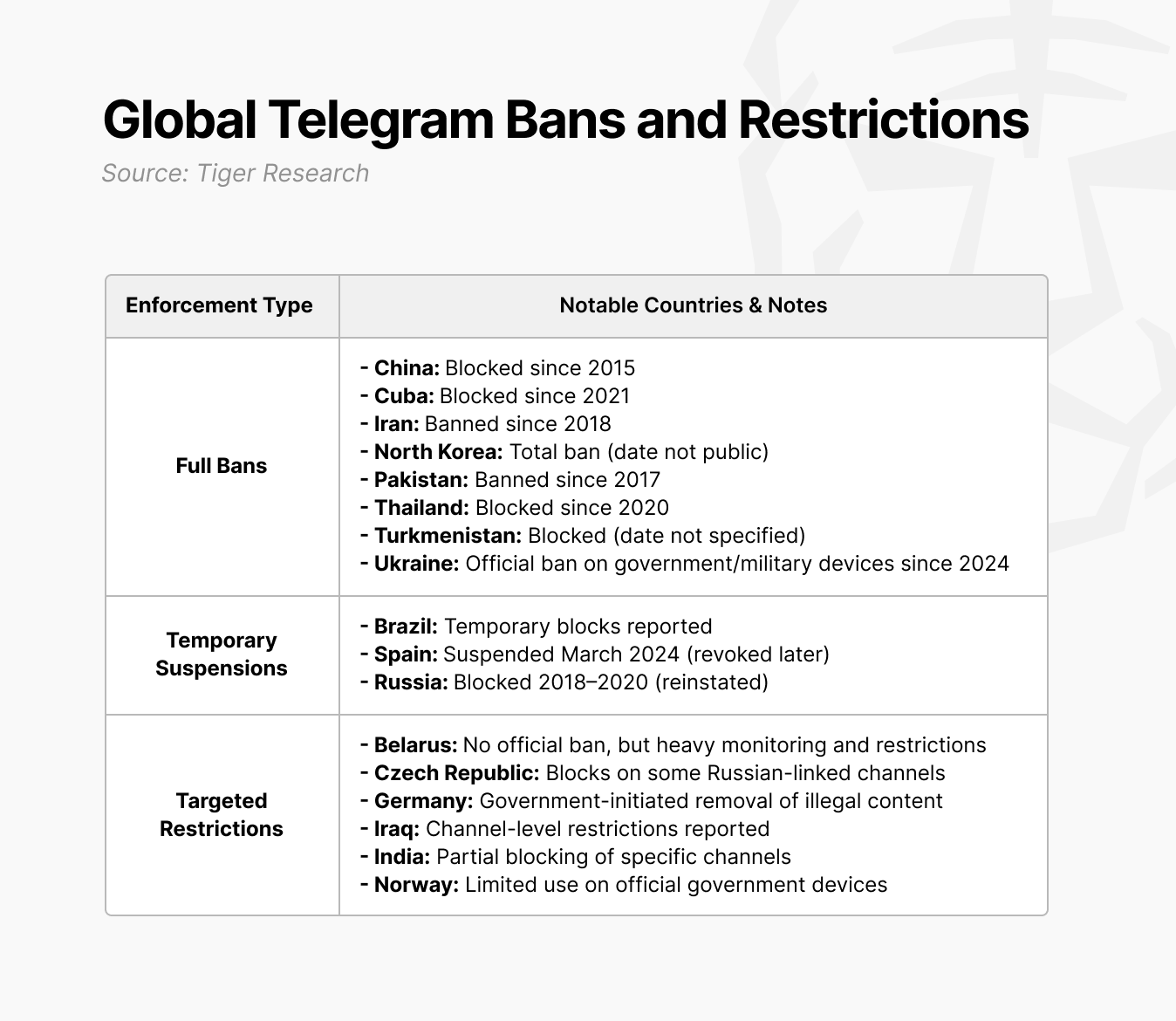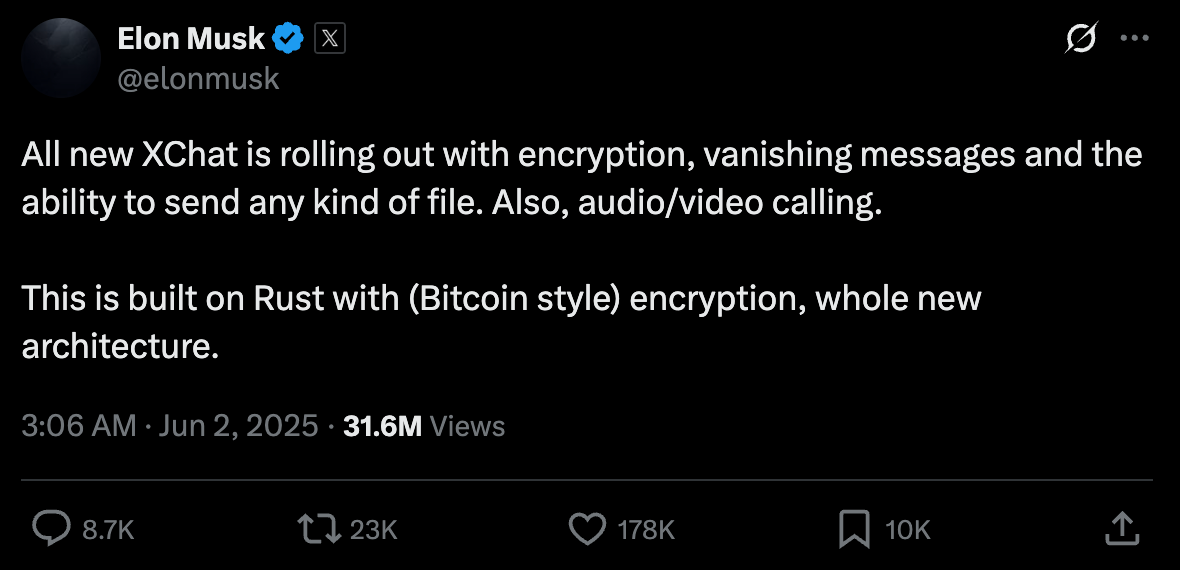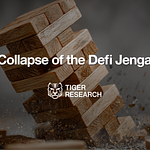This report was written by Tiger Research, analyzing the hidden risks in the cryptocurrency market stemming from the irreplaceable dependence on Telegram and examining the structural vulnerabilities exposed by Vietnam's Telegram ban.
TL;DR
Platform Dependency Risk Exposed: In June 2025, Vietnam’s ban on Telegram led to a 45% drop in user activity across major crypto communities within days. The event underscored a critical structural vulnerability: the crypto industry's heavy reliance on a single, irreplaceable communication platform.
No Viable Substitutes: Alternatives such as Discord, Signal, and local messaging apps were explored but failed to replicate Telegram’s combination of global reach, privacy features, and crypto-native user experience. No other platform currently matches this set of characteristics at scale.
Rising Regulatory Pressure Worldwide: Governments worldwide are intensifying scrutiny of Telegram under the banner of “digital sovereignty,” targeting its resistance to data-sharing and surveillance. However, Telegram has recently begun cooperating with authorities in select jurisdictions, easing concerns in some key markets—for now.
1. Telegram’s Role in the Crypto Market
Telegram has become the primary communication platform for the global crypto community, supported by strong privacy protections, scalable group chats, and bot integration. These features have made it the preferred choice for KOL and new projects to build their communities. Market participants actively use Telegram as their main channel for interaction.
Telegram now plays a central role in the structure of the crypto market. Its presence is often taken for granted, but the depth of its integration becomes clear when imagining a major event like Token2049 without it—where participants would instead exchange LinkedIn profiles. The scene feels noticeably out of place. At this point, a crypto ecosystem without Telegram is difficult to envision.
2. Vietnam’s Full Ban on Telegram
On May 21, 2025, Vietnam’s Ministry of Information and Communications issued Order No. 2312/CVT-CS at the request of the Ministry of Public Security, instructing all telecom providers to block Telegram services within the country by June 2.
The move triggered immediate disruption across Vietnam’s crypto ecosystem. Vietnam ranks among Telegram’s largest user bases globally, and like many other markets, its domestic crypto sector relied heavily on the platform as its primary communication channel. The ban left local crypto projects and users without a viable alternative. Although many turned to VPNs to maintain access, this workaround proved to be a temporary and partial solution at best.
For casual users with only a moderate interest in crypto, accessing Telegram via VPN proved too inconvenient. As a result, many disengaged altogether. Within just a few days, the average view count across ten major Vietnamese crypto communities dropped by over 45%.
In response, community organizers began exploring and promoting alternative platforms. Discord saw a sharp increase in Vietnamese server activity, while some communities experimented with local messaging apps like Zalo, aiming to accommodate users seeking a lighter, simpler interface.
However, none of these alternatives replicated Telegram’s unique balance of usability, privacy, and crypto-native features. Despite the ban, the majority of users continue to rely on Telegram via VPN—a workaround, but not a replacement.
3. Is There a Viable Alternative to Telegram?
Regulatory pressure on Telegram has revealed a structural vulnerability in the crypto industry: its heavy dependence on a single communication platform.
As seen in the Vietnam case, the immediate response to the ban was the widespread use of VPN. While this offered a short-term workaround, it created significant friction for casual users. Despite growing institutional participation in crypto, retail investors still account for a substantial portion of market activity. At a time when the market is transitioning beyond its early-stage user base, Telegram dependence has become a barrier to broader adoption.
This has prompted the industry to actively explore alternative platforms. Discord emerged as the first option for many Vietnamese communities, offering real-time communication and a developer-friendly environment. However, it lacked the mobile-first simplicity that Telegram provides. Signal, another candidate, promoted strong security features but offered limited tooling for crypto-native use cases—making it an incomplete substitute.
Other messaging apps such as Zalo or WhatsApp tend to have user bases limited to specific regions. This makes them misaligned from the outset with the global nature of the crypto ecosystem, which requires cross-border communication by default.
Ultimately, the crypto industry has not found a viable replacement for Telegram. While its technical strengths such as anonymity, privacy, and bot integration contribute to its continued dominance, the underlying issue is structural.
There is no universally adopted messaging platform that operates seamlessly across borders. Since messaging preferences differ from country to country, identifying a single alternative that meets the global needs of the crypto ecosystem remains a significant challenge.
Telegram occupies a rare position in the messaging landscape. It does not dominate any single national market, and for many users, it is not their primary app. Yet it is often the second most-used messenger across diverse regions. This unique status—as a common secondary platform—gives Telegram a kind of de facto neutrality that crosses borders. It is precisely this region-agnostic position that makes it so difficult to replace.
4. Growing Regulatory Risk Around Telegram
Despite the lack of viable alternatives, governments around the world, including Vietnam, are tightening their scrutiny of Telegram under the banner of “digital sovereignty.”
This is largely due to Telegram’s strong privacy policies and its general refusal to share user data, except with a few major jurisdictions. For many governments, the inability to monitor encrypted communications on the platform remains a core concern.
These concerns are increasingly translating into regulatory actions. Countries that have already taken steps against Telegram typically follow one of three strategies. The first is a full ban, often accompanied by a push for domestic alternatives. The second involves temporary suspensions in response to specific incidents, such as legal non-compliance or election-related tensions. The third is selective filtering, where governments allow access to the app but block specific channels or throttle its speed.
The precedent set by these cases signals that further restrictions may be on the horizon. Several countries are now considering full or partial bans on Telegram. While the political rationale varies by country, the regulatory patterns are becoming more consistent. Governments typically cite national security, non-compliance with local laws, or risks to public order as justification for control.
In this context, how Telegram responds is becoming a key variable. Although the trigger points differ by jurisdiction, the underlying issue is the same: Telegram’s unwillingness or inability to meet local compliance requirements. In countries with stricter regulatory environments, tolerance for uncooperative platforms is significantly lower.
However, there are emerging signs of a shift in Telegram’s approach. Following the arrest of CEO Pavel Durov, the company has begun taking steps to improve regulatory compliance. One notable example is its publication of a transparency report disclosing IP addresses and phone numbers of violators, but only in jurisdictions with strong democratic institutions.
Although limited in scope, Telegram is now showing more willingness to cooperate with government requests than in the past. This shift is expected to reduce the risk of immediate sanctions in major markets such as the United States.
5. What If Telegram Is Banned Completely?
A global ban on Telegram remains unlikely, but concerns among national governments are real and growing. If such a scenario were to occur, the initial user response would likely mirror the Vietnamese case, with increased use of VPNs. However, as shown above, this approach is only a short-term workaround.
In the event of a full ban, users would begin migrating to alternative services. As previously discussed, the most viable replacements are not Telegram clones or local messengers. Platforms that share Telegram’s region-neutral characteristics are more likely to gain traction.
Signal, which has recently seen increased adoption, is one potential candidate. However, a stronger contender may be XChat, the upcoming messaging service from X (formerly Twitter). Given X’s deep integration into the crypto community, XChat could leverage its existing user base for a strong market entry.
The more immediate risk, however, lies in the potential impact on the TON Foundation. While officially separate from Telegram, the relationship between the two is close. Telegram-native T2E games have been central to TON ecosystem growth. The ease of using TON wallets directly within the Telegram interface has also been a key advantage.
The expansion of ban measures turns this integration into a point of risk. If access to Telegram is blocked, user acquisition and transaction flows for TON-integrated applications are immediately affected. Even if the blockchain continues to function normally, the impact remains. Since the market perceives Telegram and TON as a unified platform, TON-based projects face direct exposure to reputational and operational risks.
While a global ban on Telegram remains unlikely, the industry must confront the practical reality that viable alternatives are limited. More broadly, the crypto ecosystem depends not only on Telegram but on several single points of service across its infrastructure. If these structural vulnerabilities are left unaddressed, the industry will remain exposed to sudden external shocks.
The path forward is clear. Reducing overreliance and diversifying platforms is no longer optional. It is a necessary survival strategy.
🐯 More from Tiger Research
Read more reports related to this research.Disclaimer
This report has been prepared based on materials believed to be reliable. However, we do not expressly or impliedly warrant the accuracy, completeness, and suitability of the information. We disclaim any liability for any losses arising from the use of this report or its contents. The conclusions and recommendations in this report are based on information available at the time of preparation and are subject to change without notice. All projects, estimates, forecasts, objectives, opinions, and views expressed in this report are subject to change without notice and may differ from or be contrary to the opinions of others or other organizations.
This document is for informational purposes only and should not be considered legal, business, investment, or tax advice. Any references to securities or digital assets are for illustrative purposes only and do not constitute an investment recommendation or an offer to provide investment advisory services. This material is not directed at investors or potential investors.
Terms of Usage
Tiger Research allows the fair use of its reports. ‘Fair use’ is a principle that broadly permits the use of specific content for public interest purposes, as long as it doesn't harm the commercial value of the material. If the use aligns with the purpose of fair use, the reports can be utilized without prior permission. However, when citing Tiger Research's reports, it is mandatory to 1) clearly state 'Tiger Research' as the source, 2) include the Tiger Research logo. If the material is to be restructured and published, separate negotiations are required. Unauthorized use of the reports may result in legal action.


















